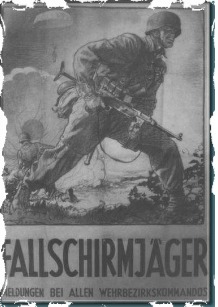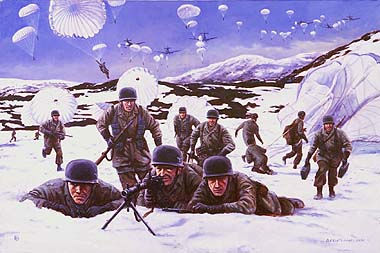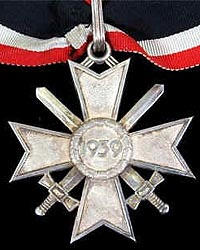|
|
Fallschirmjagers of The Luftwaffe.
 Fallschirmjager translated means Paratrooper Hunter. They were the elite airborne and ground units of the Luftwaffe. On 11th May 1936, Major Bruno Oswald Brauer made the first parachute jump from a wing of a Klemm KL25 sporting aircraft and became the first German Fallschirmjager to be given a Fallschirmschutzenschein (parachuting licence). On 5th November 1936, the Fallschirmjager would be awarded the Fallschirmschutzenabzeichen (Paratrooper Insignia featuring a gold eagle gripping the letters FJ.) Fallschirmjager translated means Paratrooper Hunter. They were the elite airborne and ground units of the Luftwaffe. On 11th May 1936, Major Bruno Oswald Brauer made the first parachute jump from a wing of a Klemm KL25 sporting aircraft and became the first German Fallschirmjager to be given a Fallschirmschutzenschein (parachuting licence). On 5th November 1936, the Fallschirmjager would be awarded the Fallschirmschutzenabzeichen (Paratrooper Insignia featuring a gold eagle gripping the letters FJ.)
The German military was among the first to drop soldiers into battle far behind enemy lines. They would take this concept to new levels and use these airborne soldiers in the first operations of WWII. These airborne soldiers would become known to the world as Fallschirmjagers.
 During World War II the,Luftwaffe raised a variety of Fallschirmjager units. Unlike practice in the Commonwealth and USA, these infantrymen were part of the air force rather than the regular army. Starting from a small collection of Fallschirmjager battalions at the beginning of the war, the Luftwaffe built up a division-sized unit of three Fallschirmjager regiments plus supporting arms and air assets, known as the 7th Air Division. During World War II the,Luftwaffe raised a variety of Fallschirmjager units. Unlike practice in the Commonwealth and USA, these infantrymen were part of the air force rather than the regular army. Starting from a small collection of Fallschirmjager battalions at the beginning of the war, the Luftwaffe built up a division-sized unit of three Fallschirmjager regiments plus supporting arms and air assets, known as the 7th Air Division.
Later in the war the 7th Air Division's Fallschirmjager assets were reorganized and used as the core of a new series of elite Luftwaffe infantry divisions, numbered in a series beginning with the 1st Fallschirmjager Division.These formations were organized and equipped as motorized infantry divisions, and often played a "fire brigade" role on the western front. Their constituents were often encountered on the battlefield as ad hoc battlegroups detached from a division or organized from miscellaneous available assets. In accord with standard German practice these battlegroups were called by their commander's name, such as Group Erdmann in France and the Ramcke Parachute Brigade in North Africa.
 After mid-1944 Fallschirmjager troops were no longer trained as parachutists due to the realities of the strategic situation, but they still retained the Fallschirmjager honorific. Near the end of the war the series of new Fallschirmjager divisions extended to over a dozen, with a concomitant reduction in quality in the higher-numbered units of the series. (These divisions are not to be confused with the Luftwaffe Field Divisions, a poorly organized and managed series of infantry divisions raised from excess Luftwaffe personnel early in the war.) After mid-1944 Fallschirmjager troops were no longer trained as parachutists due to the realities of the strategic situation, but they still retained the Fallschirmjager honorific. Near the end of the war the series of new Fallschirmjager divisions extended to over a dozen, with a concomitant reduction in quality in the higher-numbered units of the series. (These divisions are not to be confused with the Luftwaffe Field Divisions, a poorly organized and managed series of infantry divisions raised from excess Luftwaffe personnel early in the war.)
The Fallschirmjager Ten Commandments
1. You are the chosen ones of the German Army. You will seek combat and train yourselves to endure any manner of test. To you, the battle shall be fulfillment.
2. Cultivate true comradeship, for by the aid of your comrades you will conquer or die.
3. Beware of talking. Be not corruptible. Men act while women chatter. Chatter may bring you to the grave.
4. Be calm and prudent, strong and resolute. Valour and enthusiasm of an offensive spirit will cause you to prevail in the attack.
5. The most precious thing in the presence of the foe is ammunition. He who shoots uselessly, merely to comfort himself, is a man of straw who merits not the title of Parachutist.
6. Never surrender, to you death or victory must be a point of honour.
7. You can triumph only if your weapons are good. See to it that you submit yourself to this law - first my weapon and then myself.
8. You must grasp the full purpose of every enterprise, so that if your leader is killed you can fullfil it.
9. Against an open foe, fight with chivalry, but to a guerilla, extend no quarter.
10. Keep your eyes wide open. Tune yourself to the top most pitch. Be nimble as a greyhound, as tough as leather, as hard as Krupp steel and so you shall be the German warrior incarnate.
Fallschirmjager participated in many famous battles, including the airborne seizure of Fort Eben- Emael and airdrops in Norway in 1940, and the defense of Carentan during the Battle of Normandy in 1944. Their most famous airdrop was in the Battle of Crete in 1941, where the entire 7th Air Division division was deployed along with other assets such as the German 22nd Air Landing Division. The operation was successful in capturing Crete, but the high casualties among the Fallschirmjager convinced Hitler that such mass airdrops were no longer feasible - though it has to be noted that surprise was lost even before the drops started, and the battle might have caused less German casualities otherwise touxiang. Still, the Allies would come to a similar conclusion near the end of the war, as each successive large-scale airdrop resulted in higher and higher casualties.
During the Battle of Monte Cassino, the 1st Fallschirmjager Division, operating as ordinary infantry, held out for months against repeated assaults and heavy bombardment and earned the nickname "Green Devils" by the Allied forces for their tenacious defense, though they were finally forced out of the position by Polish and French Morrocan forces.
Germany also raised other small airborne units not associated with the Luftwaffe, such as parachute and commando units in the Waffen SS and the Brandenberger commandos under the direct control of OKW.
 The Battle for Norway The Battle for Norway
by David Pentland.
In this, the first true parachute operation of World war two, German paratroops of 1st battalion Fallschirmjager Regiment 1, proved themselves an invaluable component of Blitzkrieg. First in the initial stages of the campaign by seizing airfields and bridges in Norway and Denmark, and subsequently by supporting army ground forces engaged at Narvik.
 Operation Mercury Operation Mercury
Operation Mercury, was the first operation conducted entirely by airborne troops. The target was the Greek island of Crete. The Fallschirmjagers would eventually take the island, in a hard won 10 day battle.
After Crete, the Fallschirmjagers would never again be used in large scale airborne operations. However, these highly trained, elite soldiers would conduct smaller scale operations throughout the war, culminating in the pinnacle battle that won them there place in the annals of military history. That place was a Benedictine Monastary, on a hilltop town, in Italy called Monte Cassino.
Monte Cassino, west of the Italian hill town of Cassino, has often been called one of the sentinels on the road to Rome. And during WWII no one understood that better then the Germans.
Fieldmarschall Albert Kesselring, commander in chief of German units in Italy in 1944, utilized both Monte Maio and Monte Cassino as strongpoints in his defense against the Allied forces advancing up the boot of Italy. If the Allies were to penetrate the Liri Valley, one of those bastions had to be eliminated. Cassino was chosen.
Monte Cassino, with a 400-year-old abbey at its crest, was no stranger to war. It had been ransacked on two other occasions, and its inhabitants, Benedictine monks, now made ready for a third assault. And it is well that they did, for the Battle of Cassino, which began January 17,1944, would rage on and on for about four months and would result in some 175,000 casualties (115,000 Allied, 60,000 Germans)
 The German defenders wrote a special page for themselves in the annals of military history, under the category of stubborness. The 1st Fallschirmjager Division in particular impressed its adversaries by digging in and enduring relentless poundings by artillary and bombs-and then emerging to throw back one Allied assault after another. The Germans paid no less heavily than the Allies for there tenacity-at the end of the battle, for example,the 1st Company of the 1st Battalion of the 3rd Fallschirmjager Regiment was down to one officer,one NCO and one soldier. The German defenders wrote a special page for themselves in the annals of military history, under the category of stubborness. The 1st Fallschirmjager Division in particular impressed its adversaries by digging in and enduring relentless poundings by artillary and bombs-and then emerging to throw back one Allied assault after another. The Germans paid no less heavily than the Allies for there tenacity-at the end of the battle, for example,the 1st Company of the 1st Battalion of the 3rd Fallschirmjager Regiment was down to one officer,one NCO and one soldier.
Eben Emael
At the opening moments of The Battle of France, Strategic objectives had to be taken to allow the advancing German 6th Army to pass un-hindered into Belgium as part of Fall Gelb (case yellow). These objectives were three bridges over the Albert Canal at Veldvezeldt, Vroenhoven and Kannes and the fortress of Eben Emael. Eben Emael was considered to be virtually impregnable due to its location. It measured approximately 700m east to west and 900m north to south. It had a formidable arsenal of sixteen 75mm and two 120mm artillery pieces in 4 casemates and 3 revolving turrets.
It was decided that a parachute assault was out of the question due to the limited space at Eben Emael and the chance of some men missing the drop zone. It would have to be carried out in light assault gliders. They met sometimes quite stiff resistance from the Belgian defenders, who had even resorted to firing shells set with the minimum fuse settings. At one stage Leutnant Delica called in Stukas to bomb the stubborn objectives. The stukas did not  succeed in destroying the targets but forced the gunners to keep their heads down whilst the engineers went to work placing their charges. One by one their objectives were destroyed and they held out until 1000 on the morning of the 11th when they linked up with men of the 51st Pioneer Battalion. Together they started to sweep the last of the resistance from the fort and made way for the Motorised Section of the Engineer Battalion to get through and relieve the Para assault group. Knowing the battle was lost; the Belgian commander Major Jottrand, surrendered the Fortress at midday on the 11th of May. succeed in destroying the targets but forced the gunners to keep their heads down whilst the engineers went to work placing their charges. One by one their objectives were destroyed and they held out until 1000 on the morning of the 11th when they linked up with men of the 51st Pioneer Battalion. Together they started to sweep the last of the resistance from the fort and made way for the Motorised Section of the Engineer Battalion to get through and relieve the Para assault group. Knowing the battle was lost; the Belgian commander Major Jottrand, surrendered the Fortress at midday on the 11th of May.
The German Airborne forces were awarded a total of 134 Knights Crosses between the years 1940-1945. The actions in the west saw the award of 24 KC, where as the following year after Crete 27 were awarded. Out of the 134 KC, 15 were with oakleaves, 5 with oakleaves and swords and 1 with oakleaves, swords and diamonds.

|
|
|


 The Battle for Norway
The Battle for Norway

 Fallschirmjager translated means Paratrooper Hunter. They were the elite airborne and ground units of the Luftwaffe. On 11th May 1936, Major Bruno Oswald Brauer made the first parachute jump from a wing of a Klemm KL25 sporting aircraft and became the first German Fallschirmjager to be given a Fallschirmschutzenschein (parachuting licence). On 5th November 1936, the Fallschirmjager would be awarded the Fallschirmschutzenabzeichen (Paratrooper Insignia featuring a gold eagle gripping the letters FJ.)
Fallschirmjager translated means Paratrooper Hunter. They were the elite airborne and ground units of the Luftwaffe. On 11th May 1936, Major Bruno Oswald Brauer made the first parachute jump from a wing of a Klemm KL25 sporting aircraft and became the first German Fallschirmjager to be given a Fallschirmschutzenschein (parachuting licence). On 5th November 1936, the Fallschirmjager would be awarded the Fallschirmschutzenabzeichen (Paratrooper Insignia featuring a gold eagle gripping the letters FJ.) During World War II the,Luftwaffe raised a variety of Fallschirmjager units. Unlike practice in the Commonwealth and USA, these infantrymen were part of the air force rather than the regular army. Starting from a small collection of Fallschirmjager battalions at the beginning of the war, the Luftwaffe built up a division-sized unit of three Fallschirmjager regiments plus supporting arms and air assets, known as the 7th Air Division.
During World War II the,Luftwaffe raised a variety of Fallschirmjager units. Unlike practice in the Commonwealth and USA, these infantrymen were part of the air force rather than the regular army. Starting from a small collection of Fallschirmjager battalions at the beginning of the war, the Luftwaffe built up a division-sized unit of three Fallschirmjager regiments plus supporting arms and air assets, known as the 7th Air Division. After mid-1944 Fallschirmjager troops were no longer trained as parachutists due to the realities of the strategic situation, but they still retained the Fallschirmjager honorific. Near the end of the war the series of new Fallschirmjager divisions extended to over a dozen, with a concomitant reduction in quality in the higher-numbered units of the series. (These divisions are not to be confused with the Luftwaffe Field Divisions, a poorly organized and managed series of infantry divisions raised from excess Luftwaffe personnel early in the war.)
After mid-1944 Fallschirmjager troops were no longer trained as parachutists due to the realities of the strategic situation, but they still retained the Fallschirmjager honorific. Near the end of the war the series of new Fallschirmjager divisions extended to over a dozen, with a concomitant reduction in quality in the higher-numbered units of the series. (These divisions are not to be confused with the Luftwaffe Field Divisions, a poorly organized and managed series of infantry divisions raised from excess Luftwaffe personnel early in the war.) Operation Mercury
Operation Mercury The German defenders wrote a special page for themselves in the annals of military history, under the category of stubborness. The 1st Fallschirmjager Division in particular impressed its adversaries by digging in and enduring relentless poundings by artillary and bombs-and then emerging to throw back one Allied assault after another. The Germans paid no less heavily than the Allies for there tenacity-at the end of the battle, for example,the 1st Company of the 1st Battalion of the 3rd Fallschirmjager Regiment was down to one officer,one NCO and one soldier.
The German defenders wrote a special page for themselves in the annals of military history, under the category of stubborness. The 1st Fallschirmjager Division in particular impressed its adversaries by digging in and enduring relentless poundings by artillary and bombs-and then emerging to throw back one Allied assault after another. The Germans paid no less heavily than the Allies for there tenacity-at the end of the battle, for example,the 1st Company of the 1st Battalion of the 3rd Fallschirmjager Regiment was down to one officer,one NCO and one soldier. succeed in destroying the targets but forced the gunners to keep their heads down whilst the engineers went to work placing their charges. One by one their objectives were destroyed and they held out until 1000 on the morning of the 11th when they linked up with men of the 51st Pioneer Battalion. Together they started to sweep the last of the resistance from the fort and made way for the Motorised Section of the Engineer Battalion to get through and relieve the Para assault group. Knowing the battle was lost; the Belgian commander Major Jottrand, surrendered the Fortress at midday on the 11th of May.
succeed in destroying the targets but forced the gunners to keep their heads down whilst the engineers went to work placing their charges. One by one their objectives were destroyed and they held out until 1000 on the morning of the 11th when they linked up with men of the 51st Pioneer Battalion. Together they started to sweep the last of the resistance from the fort and made way for the Motorised Section of the Engineer Battalion to get through and relieve the Para assault group. Knowing the battle was lost; the Belgian commander Major Jottrand, surrendered the Fortress at midday on the 11th of May.